National Health Service 70th Anniversary
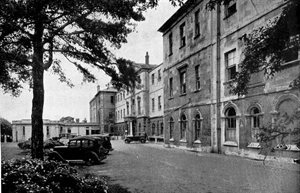
Billing Road 1948Following the Second World War it became apparent that the health of the nation needed improving and that healthcare should be available to all the population. The National Insurance Act of 1911 had helped to some extent with medical expenses and sick pay but only the bread-winner was insured, not the other members of the family. It was estimated that 50% of the population was not covered and relied on charity. For many this meant that frequently the doctor was not consulted because a fee was required of 5s.or 3s.6d for the less well off and on top of that fee medicines were added to the bill. Patients who delayed seeking help because of costs were often beyond help by the time they consulted their family doctor.
Click all pictures to enlarge. Right: Billing Road entrance in 1948
The voluntary hospitals were in need of re-organisation and were struggling financially. A reminder of those times and the state of the nation’s health included high death rates from a range of infectious diseases not yet controlled by vaccines and antibiotics. Most babies were home births and the GP was only called upon in emergency situations. Poor housing and nutrition still lingered after years of rationing and so the new health service had many challenges to meet in 1948.
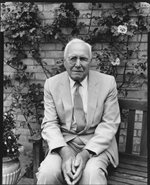 In 1944 the first National Service Act was published and the final one was embodied in 1946. Here at NGH an informal meeting took place on 13th November that year, chaired by Dr GE Godber, Senior Medical Officer of the Ministry of Health (left). He had come along to explain to the existing committee how the new system would work.
In 1944 the first National Service Act was published and the final one was embodied in 1946. Here at NGH an informal meeting took place on 13th November that year, chaired by Dr GE Godber, Senior Medical Officer of the Ministry of Health (left). He had come along to explain to the existing committee how the new system would work.
The country was to be divided into 16-20 regions and each region would be connected to a university and be responsible for a population of around two million. Northamptonshire, it was decided, was to be part of the Oxford Regional Board. Nationwide, the NHS would take ownership of 2,668 hospitals and 250 opted out of the system, which were mainly religious establishments.
Dr Godber then explained the management structure and who the members of the local committee would be built around. They should be persons with no political or personal business interests. A medical man and a finance member would be useful. They would not run the hospital services, but manage at a local level. Our Hospital Management Committee would be responsible for NGH, Creaton and the isolation hospitals, St. Edmund’s Hospital and Manfield Orthopaedic Hospital. The next band were the House Committees, who managed the day to day running, but didn’t decide policies.
The service would be financed from the Treasury and our budget would be submitted to the regional board at Oxford, and it was Mr G Sturtridgequoted in the minutes:
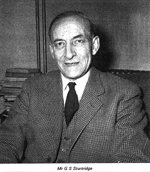 “ The Regional Board would have complete freedom in expending it [the budget] without tutelage or interfering from Whitehall. They were not merely tools of the Minister to do as they were told.”
“ The Regional Board would have complete freedom in expending it [the budget] without tutelage or interfering from Whitehall. They were not merely tools of the Minister to do as they were told.”
When the NHS was introduced Mr Gordon Sturtridge (right) had a change of role at the hospital, up to that point he had held the post of Medical Superintendent for almost 10 years. After the transition he returned to his speciality of gynaecology and obstetrics at the hospital and a unit was named in his memory in 1970.Miss Bate, Lady Almoner
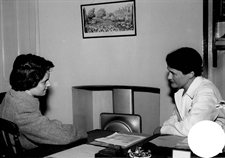 Demands on the new NHS increased dramatically after its introduction with patients no longer having worries about the cost of care. The roles of Lady Almoners (left) were greatly affected. Pre-NHS a large part of their role was assessing who could afford to pay for treatment and who needed charitable assistance. Post-NHS it was the sheer volume of patients now attending the local hospital with all their attendant social needs
Demands on the new NHS increased dramatically after its introduction with patients no longer having worries about the cost of care. The roles of Lady Almoners (left) were greatly affected. Pre-NHS a large part of their role was assessing who could afford to pay for treatment and who needed charitable assistance. Post-NHS it was the sheer volume of patients now attending the local hospital with all their attendant social needs
It was feared that after the introduction of the NHS that all the volunteer committee members and community bodies would feel redundant. This was not to be the case as they still continued to support their local hospitals. Some are mentioned here:
- War Memorial Appeal Fund – raised £170,000 to build the new Out-patient Department.
- Northampton and District Hospital Guild
- Merry Comrades Circle
- Wolverton Works Comforts Fund and Ambulance Fund
- Friends of St. Edmund’s Hospital
- Library Services for patients – Toc H and the Red Cross
Countless other benefactors and supporters in the local community also continued contributing because even from the beginning the NHS always needed additional funding for patient’s amenities and equipment.
Prior to the NHS the consultants earned their living solely by fees paid by private patients and if they chose would treat other patients free of charge. They would now decide whether they wished to be employed whole or part-time by the NHS and receive a salary.
In conclusion, 70 years on, despite the trials and tribulations of the NHS today, when it was introduced the concept of offering health care to everyone, ‘free at the point of entry,’ was miraculous.
Spot the difference! NGH in 1948 - and a more recent shot from 2010 (click each picture to enlarge)
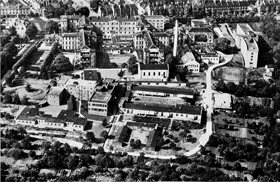
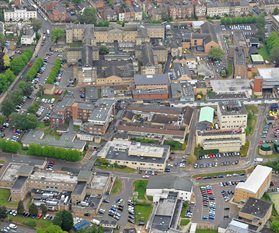
Return to Our History main menu.